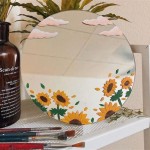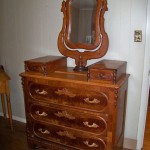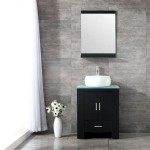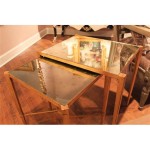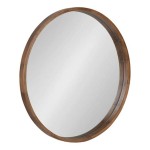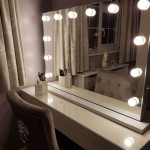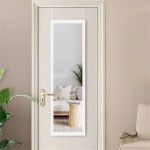How to Remove a Wall Bathroom Mirror
Bathroom mirrors are often a staple in any home, providing a vital function for personal grooming and enhancing the overall aesthetic of the space. Over time, however, the mirror may need to be replaced due to damage, wear, or a simple desire for a new style. Removing a wall-mounted bathroom mirror might seem like a daunting task, but it is a relatively straightforward process that can be accomplished with the right tools and a bit of patience. This article will guide you through the steps to safely and efficiently remove a bathroom mirror from its wall mount.
Assessing the Mirror Mount
The first step in removing a bathroom mirror is to determine how it is attached to the wall. There are several common methods, each requiring a slightly different approach:
- Adhesive: Some mirrors are adhered to the wall using a strong adhesive, often a type of construction adhesive. These mirrors usually do not have visible screws or nails.
- Screws or Nails: Many mirrors are mounted to the wall using screws or nails hammered into the wall studs or drywall anchors. These mirrors will typically have visible screws or nailheads around the perimeter.
- Brackets: Some mirrors are secured using brackets attached to the wall, with the mirror itself sliding into place.
Once you have identified the mounting method, you can proceed with the appropriate removal technique.
Removing Adhesive-Mounted Mirrors
Mirrors held in place by adhesive can be the most challenging to remove without damaging the wall. The following steps can help you safely remove an adhesive-mounted mirror:
- Preparation: Protect the surrounding area with drop cloths or towels to prevent damage from falling debris or adhesive residue.
- Heat Application: Gently heat the edges of the mirror using a hairdryer or heat gun. This can help soften the adhesive and make it easier to loosen the mirror. Be careful not to apply excessive heat, as this can damage the mirror.
- Pry and Separate: Use a putty knife or thin flat object to carefully pry the mirror away from the wall, starting at one edge. Work slowly and evenly around the perimeter, applying steady pressure until the mirror is completely detached.
- Remove Adhesive Residue: After removing the mirror, you may need to clean any remaining adhesive residue from the wall. You can use a putty knife, a scraper, or a commercial adhesive remover for this purpose.
Removing Screw or Nail-Mounted Mirrors
Removing mirrors secured with screws or nails is a more straightforward process. Follow these steps:
- Locate Fasteners: Identify the screws or nails holding the mirror in place. They are usually located at the top and bottom edges of the mirror, often hidden behind decorative caps or trim.
- Remove Fasteners: Using a screwdriver or hammer and nail puller, carefully remove the screws or nails holding the mirror to the wall. Work slowly and steadily to avoid damaging the mirror or the wall.
- Remove Mirror: Gently pull the mirror away from the wall. If there is any resistance, use a flat tool to help pry it loose.
- Fill Holes: Once the mirror is removed, you may have holes left in the wall where the screws or nails were inserted. Fill these holes with spackle or patching compound, smooth the surface, and allow it to dry before painting or applying additional finish.
Removing Bracket-Mounted Mirrors
Removing mirrors secured with brackets is a simple process that can be completed with a few steps:
- Locate Brackets: Identify the brackets holding the mirror in place. These are typically located at the top and bottom of the mirror, attached to the wall with screws.
- Remove Screws: Unscrew the screws holding the brackets to the wall. Make sure to hold onto the mirror to prevent it from falling as you remove the screws.
- Lift and Remove: Once the screws are removed, gently lift the mirror off the brackets and set it aside.
- Remove Brackets: After removing the mirror, remove the brackets from the wall. If you plan on reusing the brackets, ensure they are clean and free of debris.
Tips for Safe and Efficient Mirror Removal
Regardless of the mounting method, there are several general tips to follow when removing a bathroom mirror:
- Wear Protective Gear: Wear protective gear such as gloves and safety glasses to protect yourself from sharp edges or falling debris.
- Use the Right Tools: Use the appropriate tools for the job, such as a screwdriver, hammer, nail puller, or putty knife. Avoid using tools that could damage the mirror or the wall.
- Work Slowly and Carefully: Take your time and work methodically to avoid accidents. Avoid using excessive force, as this could damage the mirror or the wall.
- Clean Up: After removing the mirror, clean up any debris or adhesive residue from the wall. This will prepare the wall for a new mirror or another decorative element.

How To Remove A Bathroom Mirror Lowe S

How To Remove A Mirror Glued The Wall Forbes Home

How To Safely And Easily Remove A Large Bathroom Builder Mirror From The Wall Site Title

How To Safely And Easily Remove A Large Bathroom Builder Mirror From The Wall Site Title

How To Remove Mirror Off Wallsafely

How To Safely And Easily Remove A Large Bathroom Builder Mirror From The Wall Site Title

How To Safely And Easily Remove A Large Bathroom Builder Mirror From The Wall Site Title

How To Remove A Frameless Mirror Like Nervous Grandma

How To Remove A Bathroom Mirror Lowe S
:strip_icc()/Design_CathieHongInteriorsPhoto_ChristyQPhotography-b2290decbe0e4d0b952f280fb7bdc896.jpg?strip=all)
How To Remove A Bathroom Mirror From The Wall

